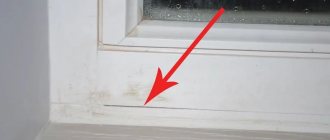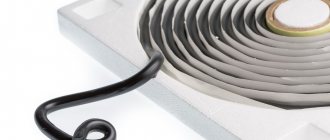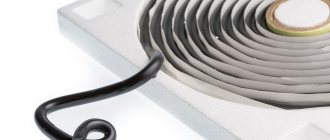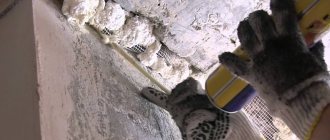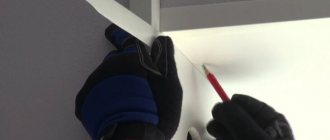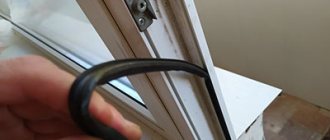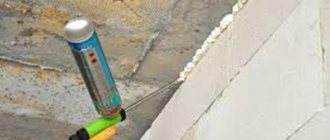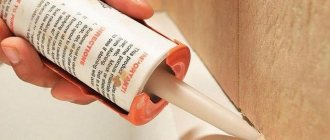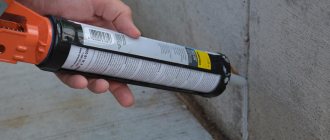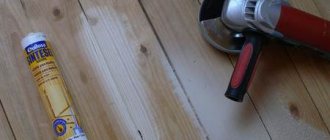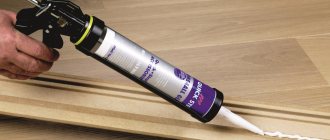Requirements for translucent structures of residential buildings
According to the above GOST R 56926-2016, design solutions for window and balcony blocks, assemblies adjacent to external wall openings must ensure water and air tightness of the building when exposed to precipitation and wind, as well as combinations of these loads.
Translucent structures must provide natural lighting of the premises at a standard level (in accordance with SP 52.13330 “Natural and artificial lighting”). Therefore, the total area of light openings should be at least one-eighth of the floor area of living rooms and kitchens.
We insulate windows for the winter - goals and purposes
The issue of insulating windows for the winter can still be solved today using old-fashioned methods, for example, sealing the cracks with paper, tape or strips of old newspapers, stuffing them with cotton wool or rags. Practical, but not at all aesthetically pleasing - this option is unlikely to suit the owner of an apartment where renovation has just been completed. Modern window sealants make it possible to insulate windows completely unnoticed - strips of sealant become part of the window, merge with it, in some cases they can be painted or you can choose a transparent, colorless option.
Article on the topic: Which plastic windows are better to install in an apartment
Modern window sealants
Some sealants are used at the window installation stage - polyurethane foam wedges the window well and fills all the voids in the walls, and is perfectly hidden under a layer of plaster or PVC or metal slopes. Others can be used immediately before the onset of cold weather, sealing cracks at the windowsill and at the junction with the wall. It should be understood that one single window sealant will not solve the problem of insulation and sound insulation - you need to use several materials in combination, for indoor and outdoor use. Before going to the construction market, decide what goals you are pursuing. Window sealant can be:
- frost-resistant
- fireproof
- for outdoor use
- for sealing seams and cracks indoors
- elastic
- for painting
- transparent
- with pigment
- UV resistant
Elastic sealant for windows
None of the existing sealants combines all these qualities. However, they are all in one bottle and are not needed. Thus, frost resistance is important for external sealants, transparency is important for sealing seams in large panoramic windows, resistance to ultraviolet radiation is useful only if the seams are not hidden under a protective layer of paint or plaster. Let's take a closer look at the existing proposals.
Why do you need window sealant: installation solution
If we consider the design of a window or balcony glazing in a simplified way, it consists of the following main elements:
- an opening in the wall for installing a window or balcony block;
- window or door balcony block.
It is impossible to ensure that the linear dimensions of the blocks perfectly coincide with the linear dimensions of the opening. You also need to take into account that with temperature changes, the linear dimensions of the opening and the window block will change differently due to differences in the characteristics of the materials from which they are made, so a gap must be provided between them.
This gap breaks the tightness of the structure, becoming a “cold bridge”, an area through which precipitation and drafts will penetrate into the room. The result will be a decrease in room temperature (and high heating costs), humidity, and mold in the corners of the windows.
Sealing a plastic window with your own hands
Treating the window opening with sealant is the final stage of installing a double-glazed window. Sealing is carried out when all installation work has already been completed, and consists of several stages:
- Installation of double-glazed windows. First, the junction seam, which is the gap between the frame and the opening, is filled with polyurethane foam. You need to wait until it dries completely so that it fills all the small irregularities and holes.
- Finishing. Then you need to cut off the protruding part of the foam and treat the outside of the seam with cement mortar.
- Sealing. Mounting sealant is applied only on the outside. You need to apply it around the entire perimeter of the seam and wait until it dries completely.
Related article: Should plastic windows fog up?
Proper sealing of a plastic window with your own hands begins with removing excess polyurethane foam. If this is not done, the seams will look uneven and the sealing will not be of very high quality. Plastering is also mandatory. The solution is applied to the joint. This will provide additional protection for the polyurethane foam. For additional insulation, it is better to lay polyurethane sealing tape around the outer perimeter before applying the sealant. If there is a strong gap between the frame and the opening, you can lay the tape directly to the wall.
Rice. 2. Sealing window seams
Places for applying sealants on translucent structures. Window sealant requirements
The following areas require sealing:
- gaps between the window block and the window opening;
- gaps between the frame and slopes;
- gaps between slopes;
- cracks in window frames;
- window sill connection;
- from the outside - the junction of the cornice to the wall.
Thus, sealing is required both indoors and outdoors.
These areas must be filled with material that meets the following requirements:
- high adhesion to the materials from which window blocks are made and to the wall material;
- thixotropy (so that it does not flow when applied along the upper horizontal and ceiling surface of the seam connecting the window and opening structures);
- elasticity;
- resistance to various adverse environmental factors (precipitation, aggressive chemical compounds, solar radiation, high and low temperatures and sudden temperature changes, vibration);
- antiseptic properties;
- aesthetic qualities (white, transparent or another color that matches the color of the frame or the possibility of painting);
- durability while maintaining all characteristics.
Sealing of windows is carried out both during the installation of window blocks and during repairs, when the old seal or sealant has ceased to perform its functions. The need for repairs can be determined by the following signs:
- draft;
- condensation on glass;
- water on the windowsill;
- mold on slopes.
Conclusion
So, let's summarize. We have already found out that sealing is a reliable means of sealing windows and increasing their thermal insulation properties . When choosing a suitable substance for sealing, it is necessary to take into account its scope of application, what material we will work with, what will subsequently affect it, whether further painting of the sealed area will be necessary or not.
The answer to the question - how to insulate windows for the winter - is very simple. Here are our tips:
- sealing agents are applied between the frame and the window sill, or between the frame and the glass.
- To insulate wooden windows, we need to remove the glazing beads from the frame, clean them of dust and dirt, paint residues, and then apply a sealing agent to the seat.
- After the final hardening, we put the glazing beads in place, but we recommend replacing the old glazing beads with new ones for reliability.
What materials are windows made from?
If the translucent filling of a window or balcony block is usually made of glass, the profile material may be different:
- PVC;
- metal with or without thermal bridge;
- tree.
PVC is most often used for windows. Balcony blocks can be plastic or metal. Wooden windows are now available in two versions:
- expensive wooden double-glazed windows;
- simple wooden frames (found in old houses, and can also be used in country houses and outbuildings as an inexpensive window option).
Thus, the sealant for window seams must have adhesion to glass, plastic, wood, metal, as well as to the materials from which the walls of buildings are made - concrete, brick, stone.
Sealing cracks in PVC structures
We figured out what sealant to use to seal cracks in plastic windows. Next, we'll look at how to do it correctly. It is assumed that PVC slopes have already been installed. Before starting work, you should prepare a syringe for sealant, a container of water, a sponge, a napkin and construction tape.
Sealing seams on PVC windows with sealant
The operating procedure will be as follows:
- The surfaces of plastic frames and slopes are prepared for sealing with a sealing compound. It is recommended to stick construction tape to these surfaces along the edge of the gap, which will remove the remaining sealant, but you don’t have to use it;
Tip: Before sealing, clean the cracks from dirt, remnants of protective film, old sealant, and dust. This will significantly enhance adhesion in these areas.
- Using a syringe, the window sealant is squeezed into the existing cracks. It is recommended to hold the syringe at an acute angle and guide it so that with its nose it simultaneously smoothes the seam;
- The protruding layer of the compound should be smoothed with a wet finger, ensuring its uniform distribution over the entire area of the seam. You need to make sure that all seam voids are filled. The sealant is removed from the finger with a napkin;
- Remains of sealant are removed with a damp sponge. This is done very carefully so as not to damage the laid layer of material. The sponge should be washed in a container of water as often as possible;
- It is better to carry out the work in stages, in small sections. Let's say you apply sealant to one joint, then level it, and then remove the remaining sealant. If this is not done, the applied composition may begin to harden, and it will no longer be possible to level it;
- The surfaces of the frame and slopes must be completely cleaned of sealant residues, as careless cleaning will leave unsightly marks on the white plastic. They will be invisible right away, but will later appear as dirty spots.
Tip: If the surface of the window sill, frame or slopes needs to be cleaned or degreased, do not use acetone-based solvents for this. Such a solvent will leave stains and stains on the surface of the plastic. It is best to use white spirit or gasoline solvent for this purpose.
Choosing a sealant for sealing window seams
Sealant is a material for filling, sealing and sealing seams, abutments and joints. It can take the form of self-adhesive tapes, sheets, and is also available in the form of polymer-based pastes or so-called liquid plastic.
Paste-like polymers can be single-component or consisting of several components. While the former are ready for use, the latter are mixed from separate components, which complicates the work.
Sealants are also classified according to the type of active substance. Depending on it, the sealant has certain characteristics, therefore, for each type of material and work, its own type of sealing material is used. Of course, the more versatile the sealant, the better.
Important!
Sealant on windows is used not only inside, but also outside. Therefore, you need to use different sealants for different types of seams or choose a universal sealant that is suitable for both external and internal work.
What sealants are not used for plastic and other types of windows
Let us first list the types of sealants that are not the best choice for windows made of PVC and other materials.
Bitumen sealants
Although today there are already non-black bitumen sealants that are resistant to high temperatures, in general they are not used for windows.
Acrylic sealants
The downside to acrylic sealant is its tendency to darken or yellow over time. When used for external seams, its low resistance to moisture becomes critical. Even waterproof and frost-resistant types of acrylic sealants begin to deteriorate when constantly exposed to high humidity.
However, acrylic window sealants are still used on external seams, but with subsequent treatment with a fungicidal compound.
What sealant to use to seal the seams of window blocks
Let's look at the sealants that are most often used for plastic, wooden and metal windows.
Thiokol sealants
Thiokol or polysulfide sealants are high-quality materials that penetrate even the smallest cracks and cracks, filling them reliably.
The advantages of thiokol sealants include:
- strength and durability;
- resistance in a wide temperature range from –55°С to +130°С;
- chemical inertness;
- water resistance;
- resistance to organic solvents;
- excellent adhesion;
- Possibility of use at low temperatures.
Thiokol sealants are used in hydraulic engineering construction and are even more suitable for windows.
The disadvantages include the need to mix sealant from 2-3 components.
Butyl rubber sealants
One-component butyl rubber sealants have good adhesion and can be applied to wet and oily surfaces. The advantages of these sealants also include:
- strength;
- stability in the temperature range from –50°С to +90°С;
- elasticity;
- water insolubility.
However, these sealants are applied only at positive temperatures. In window blocks they are used mainly for sealing seams and cracks in double-glazed windows, and for processing the joints of the frame and slopes it is better to choose a different type of sealant.
Silicone sealants
Silicone sealants in everyday life are also referred to as “plumbing” sealants, because, due to their high adhesion, elasticity, strength and water resistance, they are popular for sealing joints in bathrooms.
Silicone sealants are available in a wide range of colors, as well as in a transparent version. They are also suitable for narrow joints up to 5 mm wide.
Silicone sealants are also used for windows, but there are some limitations to their use:
- acidic varieties of silicone sealants are not suitable for window blocks with a metal profile, as they cause corrosion of the metal;
- Silicone sealants are not suitable for windows with wooden profiles because, unlike wood, they do not work well under compression (bubbles may appear);
- on external seams, silicone sealant lasts no more than 5–7 years;
- For plastic windows, silicone sealant is suitable, but the seams filled with silicone quickly become covered with dust, which is difficult to clean because it sticks to the sealant, and the appearance of the window becomes sloppy.
Siliconized sealants
These are inexpensive, durable, vapor-permeable sealants (a mixture of acrylic and silicone components), but they are not used for metal work.
Alkyd sealants
One-component sealants based on alkyd resins are available in several versions.
These are inexpensive sealants that are suitable for exterior and interior use and can be painted. With high water resistance, they retain vapor permeability, have good adhesion to wood, brick and PVC profiles, and allow work at low temperatures.
Polyurethane sealants
The most important advantage of polyurethane sealants has always been their durability.
New generations of polyurethane sealants can be considered as truly universal materials, suitable for external and internal use and compatible with any building materials.
Do-it-yourself sealing of windows with liquid plastic (sealant)
After new plastic windows are installed in your home, there will be one more problem that will need to be solved - sealing the cracks that form at the junction of the PVC panel slopes.
Such cracks not only become very noticeable, spoiling the overall picture, but they also cause drafts and dust to enter the apartment. Fixing this problem is not as difficult as it might seem at first glance, and you don’t even need to have special knowledge to do this, just buy liquid plastic (sealant) and read this article-instructions for its use.
So, what is liquid plastic? At its core, it is an adhesive that provides diffuse welding of PVC surfaces at their junction. The result of using such a tool will be the creation of a homogeneous part that has no signs of mating, as well as any color changes. In addition, the seam itself will be as mechanically stable and environmentally friendly as possible.
Adhesive sealant for seams white
CEMMIX Adhesive-sealant for seams is a one-component polyurethane sealant for sealing various seams, junctions of steps and walls, entry of pipes and ventilation systems and rigid-elastic gluing of various materials.
More details
Usage
You can carry out sealing yourself. When working, you will need a syringe, water and mounting tape. To prevent the slopes from getting dirty, you need to stick construction tape on them. Working areas should be thoroughly cleaned and degreased, but products containing acetone should not be used for PVC windows, otherwise unsightly stains will appear on the surface. Slowly squeeze the sealant into the seam using a syringe. The tool must be held at such an angle that its nose straightens the applied putty. Then everything is smoothed out with a finger dipped in water. The seams should be thoroughly filled with the product so that there are no voids left. Even before the material hardens, its excess is carefully removed from the surfaces, without disturbing the integrity of the sealant applied to the seams. The putty should not be applied to all the seams at once, but should be worked in stages.
White facade adhesive sealant
CEMMIX Facade adhesive-sealant is a special sealant based on hybrid polymers for various joints.
More details
Let's consider one-component sealants based on hybrid MS polymers - weather-resistant Cemmix Facade Sealant and Cemmix Seam Adhesive Sealant:
- sealants are designed for sealing seams up to 20 mm wide, as well as for rigid-elastic gluing of different types of materials;
- have excellent adhesion to a wide range of building materials;
- easy to apply (applied with a spatula or a construction gun, does not bubble, does not spread, and is thixotropic);
- quickly cure when exposed to atmospheric humidity (initial polymerization within 15 minutes);
- allow application at sub-zero temperatures;
- elastic;
- are not afraid of sunlight, high and low temperatures and temperature changes, vibration;
- frost-resistant;
- waterproof and chemically inert;
- mechanically strong;
- allow coloring;
- have antibacterial characteristics;
- safe for humans;
- serve for 10–25 years with preservation of properties.
Important!
Cemmix adhesive-sealant for seams is available in 4 shades, Cemmix facade sealant - in 8.
Sealant application technology
In fact, even a beginner can handle the process of applying liquid plastic to seal windows, the main thing is to strictly follow the sequence given below.
To begin, the areas that need to be treated are cleaned and degreased using a PVC cleaner. This point is very important to ensure that the sealant adheres well to the surface of the plastic. Make sure that no lint or threads remain on the surface after using rags or sponges to clean. To apply the sealant evenly and not smear unnecessary areas with it, you can stick masking tape on the window sill, using this method to create a border (about 1 mm) beyond which the sealant simply will not fall.
Next, screw a conical cap onto the tube, from which the tip is cut off. The sealant should be applied in one continuous strip. If this is your first time doing something like this, you can practice on the waste that remains after installing window sills or slopes.
The length of the seam should be no more than 50 centimeters, because otherwise it will begin to dry out. After squeezing out an even strip, the excess can also be carefully removed with a PVC cleaner.
Now you should wait a while. For silicone sealants such as PENOSIL Premium Universal Silicone, drying time is 10-25 minutes. Acrylic sealants like PENOSIL Premium Acrylic Sealant take a little longer to dry - 15-35 minutes. Polyurethane sealants such as PENOSIL PU-Sealant High Modulus will require up to 45 minutes to dry completely. The final hardening of all types of liquid plastic occurs a day after application.
Once cured, you should have one solid piece of plastic, with no visible seams.
When working with liquid plastic, you should adhere to the following safety precautions:
due to the fact that the sealant glues surfaces and the setting period is 2-4 minutes, all work should be done with gloves;
It is better to carry out work in a ventilated area, especially if you suffer from allergies or lung diseases;
the ignition temperature is +321°C.
Adhesive sealant for seams white
CEMMIX Adhesive-sealant for seams is a one-component polyurethane sealant for sealing various seams, junctions of steps and walls, entry of pipes and ventilation systems and rigid-elastic gluing of various materials.
More details
Features of tape sealants
Butyl rubber sealant is used as the basis for the tapes. The following properties of this material can be distinguished:
- it is environmentally friendly, does not emit harmful substances and does not smell;
- butyl rubber has high adhesion to almost any substrate: brick, concrete, wood, metal, plastic and glass;
- it is resistant to chemically aggressive substances;
- the material tolerates vibrations, mechanical loads and external atmospheric influences well;
- the sealant retains its properties in the temperature range from -60 °C to +80 °C, does not crack in the cold season and does not spread in the summer;
- * the material is capable of self-sealing, that is, small punctures or cuts are healed without external intervention.
Butyl rubber tapes are extremely easy to use: before use, just remove the anti-adhesive layer from their working surface, apply GSR primer to the joint being processed, apply the tape to it and press. Tapes can be applied at temperatures down to -15 °C.
White facade adhesive sealant
CEMMIX Facade adhesive-sealant is a special sealant based on hybrid polymers for various joints.
More details
Important!
For polyurethane sealants on joints requiring elasticity, the third contact surface must be eliminated. To do this, a cord made of foamed polyethylene is installed at the mouth of the seam.
Watch the video : Plastic windows. Quick sealing of joints and seams
The choice of materials for sealing windows and balconies is very wide, but each sealant has its own characteristics. Cemmix facade sealant and Cemmix adhesive-sealant for seams are universal materials that can be used when installing window units. You can buy Cemmix sealants wholesale and retail in construction networks, as well as online.
You can buy CEMMIX products without leaving your home, with discounts from 5 to 33%!!!!
Buy on Ozon
Buy on Yandex.Market
Buy on Wildberries
Buy at Leroy Merlin
Or you can find the nearest official dealer in your region on our map
← Sealant for blind areas
Waterproof and frost-resistant metal sealant for exterior use →
Return to list
Comments
How to use sealant correctly
You can seal windows yourself. First you need to prepare tools and consumables - masking tape, a container of water, a sealant gun, a spatula. The slopes are covered with tape to protect them from contamination and save time on wiping. The working area is cleaned of dust, grease, and dirt, but only approved solvents (without acetone) are used for degreasing.
The sealant is squeezed out of the tube after inserting it into the gun. The spout is placed so that it smoothes the material. Irregularities and pits are immediately leveled with a narrow spatula, moistening it with water. This will improve the adhesion of the seam to the base and eliminate the appearance of voids. The remaining sealant along with the masking tape should be removed before it hardens, otherwise the integrity of the seams may be compromised. A special sealing cord is first placed in gaps that are too wide - this will help reduce material consumption.
Sealing is done in parts to prevent the seams from hardening before they are finished. Manipulations are performed on one side of the window, and only after completion of the work they move to another area. On the outside, the product is applied only in the low tide area and along the side parts - in other places, the presence of sealant can cause moisture accumulation in the foam. In such areas, a vapor-permeable tape should be installed and plastered. Properly carried out work guarantees the durability of double-glazed windows and optimizes the thermal conductivity of the walls.
News
We are always ready to help
Cemmix has opened a free hotline
to help you with any questions related to construction using concrete additives. Call and ask, our consultants are always ready to help!
Hyperplasticizer
Hyperplasticizers are a new type of plasticizing additives for concrete, ensuring the mobility of the mixture above P5. In addition to plasticity, they increase the water resistance and frost resistance of concrete by 2-3 times.
We seal from the inside - acrylic and butyl sealants
Sealing window seams with butyl sealants often occurs already at the stage of assembling double-glazed windows at the time of production. Butyl compounds are based on a mixture of polyisobutylene and ordinary chalk. Chalk acts as a filler, and the quality of the sealant depends on its quantity. The best ratio is considered to be 50 to 50, but many manufacturers prefer to save on the more expensive polyisobutylene. Unfortunately for many consumers, the characteristics of the purchase can only be assessed some time after it has been applied and cured. Compositions with too much chalk quickly dry out, crack and crumble.
Butyl sealants are used exclusively for sealing work indoors. When choosing a composition, pay attention to the components from which it is made - if the label also indicates paraffin or industrial oil, then such a sealant will have much better adhesion to different materials.
Butyl window sealant
Another type of sealant for interior work is acrylic. This type is characterized by low vapor permeability, and therefore it is often used to protect polyurethane foam from moisture and condensation. Acrylic compounds adhere perfectly to any surface, even if they are not completely dry. The main disadvantage of acrylic sealants is their low elasticity. In frosty weather they become completely hard and may crack. Therefore, sealing window seams from the outside with such compounds does not justify itself at all. The advantages include the fact that acrylic seams can be painted in any color with almost any paint. Therefore, most of these sealants are sold in white.
Butyl tapes are not the same thing as butyl sealants. Butyl rubber is used as a polymer base in the tapes, as well as a number of plasticizers and fillers. The quality of the finished product depends on them, so butyl tapes should be purchased with great care so as not to end up with a completely unsuitable sealant. Paraffin and industrial oil are also used as a plasticizer to improve material adhesion.
When working with butyl compounds, it is important to very carefully remove any remaining dirt, paint and old putty. It doesn’t hurt to coat the areas where the seam will go with a special primer. Using acrylic sealants, you can do without any primers.
Overview of sealants for wooden frames
Window sealant has become quite popular today, and it is used mainly as a sealant for window frames and glass.
Sealant, according to its properties and characteristics, is divided into several varieties, but the most commonly used is considered to be silicone based. It owes its popularity to its almost impeccable characteristics and relatively low price, since only one component is used for its manufacture - silicone rubber.
